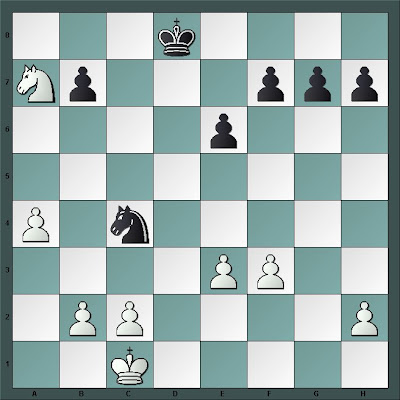Czerniak, Moshe- Najdorf, Miguel [A00]
Warsaw Match (Game 7), Oct. 1929
[Annotations: Czerniak]
1. e4 Nc6 2. d4 d5 3. Bb5 (Much better than 3. exd5 (see the 5th game of the match).) 3... dxe4 4. Nc3 (Better than the immediate 4. d5 a6 5. Ba4 b5 6. dxc6 Qxd1+ 7. Kxd1 bxa4 (-/+).) 4... Bd7 Best... 5. Bxc6 Bxc6 6. d5 Bd7 7. Nxe4 c6! 8. Nf3 cxd5 9. Qxd5 Bc6 10. Qe5 Qd5 11. Qxd5 Bxd5 12. Nc3 Bxf3?

In this position the exchange of the excellently developed bishop can be advantageous only for White. 13. gxf3 e6 14. Bd2 Nf6 15. O-O-O O-O-O 16. Bf4?

Weak. (16. Be3! should have been played, with the following play, 16... b6? (or if 16... a6 17.Bb6 with a strong positional advantage) 17. Nb5!) 16... Bc5 17. Be3 Bxe3+ 18. fxe3 Rxd1+

Black, heading for a draw, chooses the wrong road. Above all it was necessary to protect oneself (...a6!). 19. Rxd1 Rd8 $2 20. Rxd8+ Kxd8 21. Nb5

Wins a pawn. While the part of the game up till now was played quite weakly, the ending is conducted very precisely by both sides, particularly by Black. 21... Ne8! 22. Nxa7 Nd6 23. a4 To aid the trapped knight. 23... Nc4

Cutting the king off, and apparently winning a pawn... 24. Nb5! If Black takes a pawn now, Nd6 wins one back again. (If 24. e4 Ne5 25. f4 Ng6 etc.) 24... Kd7 25. e4 Ne3? 26. Kd2 Nc4+ (If 26... Nf1+ 27. Ke2 Nxh2 28. Kf2

and Black loses the knight.)
27. Kc3 Ne5 28. Nd4 g5 29. h3 h5 30. b4 f5 31. exf5 exf5 32. Nxf5 Nxf3 33. Ng3 g4 34. hxg4 hxg4

The ending reached is very hard to win; so it is no surprise that with precise play by Black the game ended drawn. 35. Kc4 Kc6 36. b5+ Kb6 37. Kb4 Nd4 38. a5+ Kc7 39. c4 Ne6 40. Ne4 Nd4 41. Ng3 Ne6 42. Nf5 At last White finds the right road. 42... Nf4

43. b6+? A mistake... (43. Kc3 led to victory.) 43... Kb8 44. Ng3 Nd3+ 45. Kb5 Ne5 46. c5

(Better was 46. Kc5 Nc6 47. a6 etc.) 46... Nc6 47. a6 Nd4+ 48. Kc4 Nc6 49. a7+ (49. axb7 gave slightly better winning chances.) 49... Ka8

(49... Nxa7 also gives a draw, as shown by Mr Przysiocki in his analysis, e.g. 50. bxa7+ Kxa7 51. Kd5 Ka8 52. Kd6 Kb8 53. Kd7 Ka7 54. Kc7 Ka8 , etc.) 50. Nf5 g3! 51. Nxg3 Ne5+ 52. Kb5 Nd7

Black threatens to capture with the knight on c5 or b6, and in either case achieves a stalemate position. 53. c6 bxc6+ 54. Ka6! Nc5+ 55. Ka5

55... Nb3+ Black carefully avoids the trap. (After 55... Nb7+? 56. Kb4 White is winning.) 56. Kb4 Nd4

Threatening ...Nb5 and ...Nxa7. 57. Ka5 Nb3+ 58. Kb4 Nd4 59. Ne4 Nb5 60. Ka5 Nxa7 61. Ka6!

61... Nb5! The only move. (After 61... Nc8 62. b7+ Kb8 63. Nf6! (63. Nc5? Nb6!!) 63... Na7 64. Nd7+ wins.) 62. Nf6 Nd6 Drawn.
No comments:
Post a Comment